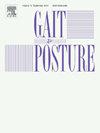Ankle-hip joint trade-off in normal gait: Exploring the kinematic influence of the medial longitudinal arch of the foot
IF 2.2
3区 医学
Q3 NEUROSCIENCES
引用次数: 0
Abstract
Background
In human gait, leg progression into the swing phase involves two primary strategies: ankle plantar flexion and hip flexion. These strategies are believed to exhibit a trade-off relationship; however, it is unclear whether this relationship holds for normal gait and the role of the medial longitudinal arch (MLA) in shaping these strategies.
Research questions
Does a trade-off relationship exist between ankle plantar flexion and hip flexion strategies during normal gait in young healthy adults? Do the kinematics of MLA during gait influence the strategies during leg progression into the swing phase?
Methods
Data from 36 young healthy adults were analyzed. Gait speed and peak moment, angular impulse, peak power and joint work at ankle plantar flexion and hip flexion were assessed within the context of the normal gait task. The parameters were also assessed using ankle-to-hip joint ratios (ankle/hip indices). Kinematics of MLA, including peak MLA angle, amount of descent, and amount of elevation during gait, were also measured. To exclude the effect of gait speed, partial correlation coefficients were employed to explore the relationship between ankle and hip variables as well as the ratio of ankle/hip indices and MLA kinematics.
Results
A significant negative correlation between ankle plantar flexion work and hip flexion work was detected. Moreover, a positive correlation between the ankle plantar flexion work to hip flexion work ratio and MLA elevation was detected.
Significance
A trade-off relationship between ankle plantar flexion and hip flexion strategies during normal gait in young healthy adults was confirmed, suggesting that these parameters are fundamental to normal gait. Additionally, the MLA elevation during late stance may influence the establishment of ankle plantar flexion and hip flexion strategies. These findings enhance our understanding of gait mechanisms and highlight the role of MLA kinematics in shaping gait strategies.
正常步态中踝关节-髋关节的权衡:探索足内侧纵弓的运动学影响
在人类步态中,腿进入摇摆阶段涉及两种主要策略:踝关节、足底屈曲和髋关节屈曲。这些策略被认为是一种权衡关系;然而,尚不清楚这种关系是否适用于正常步态和内侧纵弓(MLA)在形成这些策略中的作用。研究问题:在年轻健康成人正常步态中,踝关节、足底屈曲和髋部屈曲策略之间是否存在权衡关系?步态中MLA的运动学是否会影响腿部进入摇摆阶段的策略?方法对36例健康青年的资料进行分析。在正常步态任务的背景下评估步态速度和峰值力矩、角冲量、峰值功率和踝关节、足底屈曲和髋关节屈曲的关节功。还使用踝关节-髋关节比率(踝关节/髋关节指数)评估参数。MLA的运动学,包括峰值MLA角、下降量和步态中的上升量,也被测量。为了排除步态速度的影响,采用偏相关系数来探讨踝关节和髋关节变量以及踝关节/髋关节指数比值与MLA运动学之间的关系。结果踝关节、足底屈曲与髋部屈曲呈显著负相关。此外,足底屈曲功与髋屈曲功之比与MLA升高呈正相关。研究证实了年轻健康成人正常步态中踝关节、足底屈曲和髋部屈曲策略之间的权衡关系,表明这些参数是正常步态的基础。此外,后期站立时MLA升高可能会影响踝关节、足底屈曲和髋关节屈曲策略的建立。这些发现增强了我们对步态机制的理解,并强调了MLA运动学在步态策略形成中的作用。
本文章由计算机程序翻译,如有差异,请以英文原文为准。
求助全文
约1分钟内获得全文
求助全文
来源期刊

Gait & posture
医学-神经科学
CiteScore
4.70
自引率
12.50%
发文量
616
审稿时长
6 months
期刊介绍:
Gait & Posture is a vehicle for the publication of up-to-date basic and clinical research on all aspects of locomotion and balance.
The topics covered include: Techniques for the measurement of gait and posture, and the standardization of results presentation; Studies of normal and pathological gait; Treatment of gait and postural abnormalities; Biomechanical and theoretical approaches to gait and posture; Mathematical models of joint and muscle mechanics; Neurological and musculoskeletal function in gait and posture; The evolution of upright posture and bipedal locomotion; Adaptations of carrying loads, walking on uneven surfaces, climbing stairs etc; spinal biomechanics only if they are directly related to gait and/or posture and are of general interest to our readers; The effect of aging and development on gait and posture; Psychological and cultural aspects of gait; Patient education.
 求助内容:
求助内容: 应助结果提醒方式:
应助结果提醒方式:


